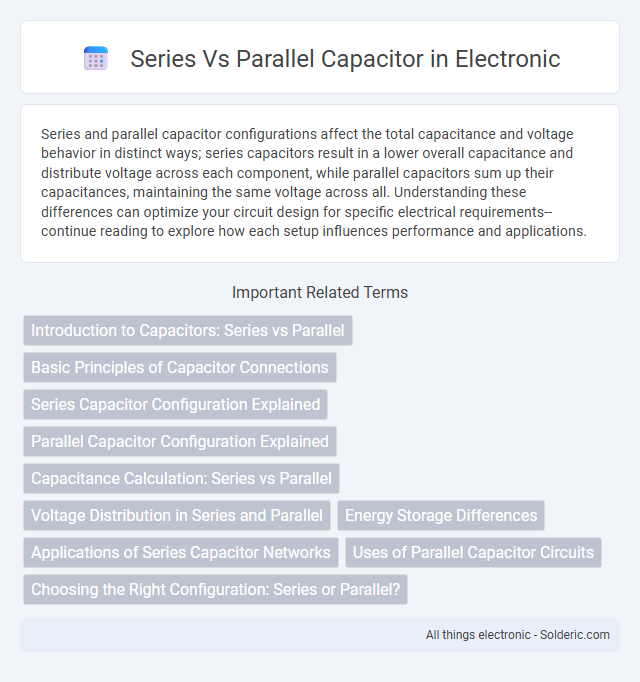Series and parallel capacitor configurations affect the total capacitance and voltage behavior in distinct ways; series capacitors result in a lower overall capacitance and distribute voltage across each component, while parallel capacitors sum up their capacitances, maintaining the same voltage across all. Understanding these differences can optimize your circuit design for specific electrical requirements--continue reading to explore how each setup influences performance and applications.
Comparison Table
| Aspect | Series Capacitor | Parallel Capacitor |
|---|---|---|
| Total Capacitance | Decreases; 1/C_total = 1/C1 + 1/C2 + ... | Increases; C_total = C1 + C2 + ... |
| Voltage Distribution | Voltage divides across capacitors | All capacitors experience same voltage |
| Charge | Same charge on each capacitor | Charge divides across capacitors |
| Effective Voltage Rating | Sum of voltage ratings (higher voltage tolerance) | Same as individual capacitor voltage rating |
| Use Cases | High voltage applications, tuning circuits | Increasing capacitance, energy storage |
| Equivalent Capacitance Formula | 1/C_eq = S (1/C_i) | C_eq = S C_i |
Introduction to Capacitors: Series vs Parallel
Capacitors in series combine to create a lower total capacitance than any individual capacitor, as the reciprocal of the total is the sum of reciprocances of each capacitor, making them ideal for applications requiring precise voltage division. In parallel, capacitors add directly, increasing total capacitance and enabling greater energy storage and smoother voltage regulation in circuits. Understanding these configurations helps you optimize capacitor performance for your electronic designs by balancing capacitance and voltage requirements.
Basic Principles of Capacitor Connections
Capacitors connected in series share the same charge, but the total voltage across the series is the sum of individual voltages, resulting in a lower overall capacitance calculated by the reciprocal formula 1/C_total = 1/C1 + 1/C2 + .... In parallel connections, capacitors experience the same voltage, and their capacitances add directly, increasing the total capacitance as C_total = C1 + C2 + .... Understanding these basic principles allows you to design circuits that meet specific voltage and capacitance requirements efficiently.
Series Capacitor Configuration Explained
In a series capacitor configuration, capacitors are connected end-to-end, resulting in a total capacitance that is less than the smallest individual capacitor value. The reciprocal formula 1/C_total = 1/C1 + 1/C2 + ... + 1/Cn governs the overall capacitance, causing voltage division across each capacitor proportional to their capacitance values. This setup is ideal for applications requiring high voltage ratings and precise capacitance tuning in electronic circuits.
Parallel Capacitor Configuration Explained
In a parallel capacitor configuration, multiple capacitors are connected across the same two points, creating a common voltage across each capacitor while the total capacitance is the sum of all individual capacitances. This setup increases the overall capacitance, allowing the circuit to store more charge at the same voltage, which improves energy storage and filtering capabilities. Parallel capacitors are commonly used in power supply circuits to smooth voltage fluctuations and enhance stability.
Capacitance Calculation: Series vs Parallel
In series capacitors, the total capacitance (C_total) is found using the reciprocal formula 1/C_total = 1/C1 + 1/C2 + ... + 1/Cn, resulting in a lower overall capacitance than any individual capacitor. Parallel capacitors add directly, with total capacitance calculated as C_total = C1 + C2 + ... + Cn, increasing the total capacitance proportionally to the number of capacitors. This difference arises because series connections share voltage across capacitors, while parallel connections share the same voltage but combine charge storage capacity.
Voltage Distribution in Series and Parallel
Voltage distribution in series capacitors divides across each capacitor inversely proportional to their capacitance, meaning smaller capacitors experience higher voltage stress. In parallel capacitor configurations, the voltage across each capacitor is uniform and equal to the source voltage, while the total capacitance sums up. Understanding this voltage behavior helps you design circuits that avoid capacitor damage and optimize performance under specific voltage conditions.
Energy Storage Differences
Series capacitors store less energy due to the reduced equivalent capacitance, which results in lower total charge storage for a given voltage. Parallel capacitors combine their capacitances, increasing total energy storage capacity by allowing more charge accumulation at the same voltage. Energy stored in capacitors is proportional to the capacitance and the square of the voltage, making parallel configurations more effective for maximizing energy storage.
Applications of Series Capacitor Networks
Series capacitor networks are widely used in high-voltage power transmission systems to improve voltage regulation and reduce reactive power flow. These networks help in controlling power flow, enhancing system stability, and increasing transmission efficiency by compensating for inductive reactance in long transmission lines. Industrial applications include adjustable series capacitor banks for dynamic reactive power compensation and harmonic filtering in electrical grids.
Uses of Parallel Capacitor Circuits
Parallel capacitor circuits are commonly used in power supply systems to stabilize voltage and filter out noise by providing a low-impedance path for high-frequency signals. They are essential in tuning applications, such as in radio frequency (RF) circuits, where precise capacitance values are needed to select specific frequencies. Your electronic devices benefit from parallel capacitor configurations by improving power quality and signal integrity.
Choosing the Right Configuration: Series or Parallel?
Selecting the correct capacitor configuration depends on your desired capacitance and voltage requirements. Series capacitors reduce overall capacitance but increase voltage rating, useful for high-voltage applications, while parallel capacitors increase total capacitance, suitable for filtering and energy storage. Understanding how series and parallel arrangements impact capacitance and voltage helps optimize your circuit performance efficiently.
Series vs parallel capacitor Infographic

 solderic.com
solderic.com